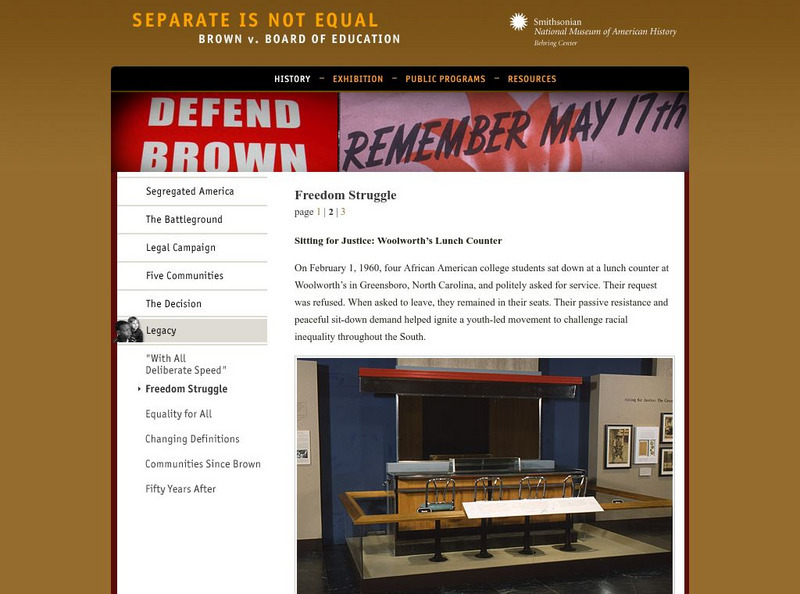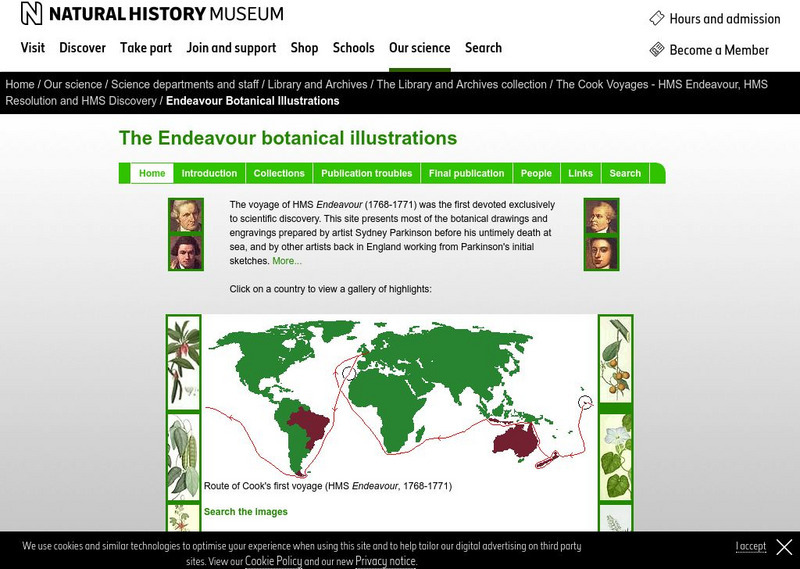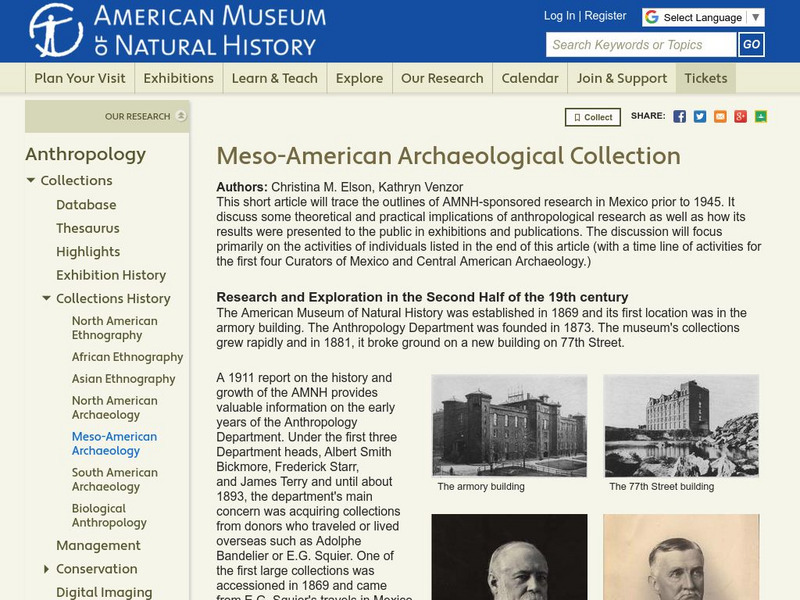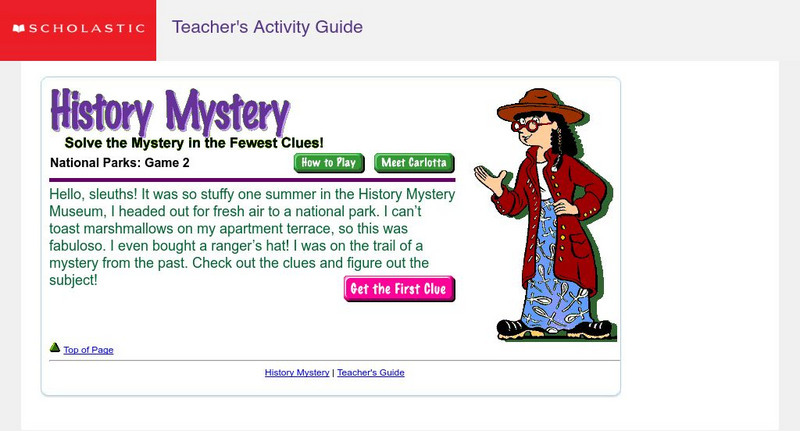Smithsonian Institution
National Museum of Natural History: Asustralopithecus Afarensis
This resource offers an excellent definition of the species, Australopithecus afarensis.
Smithsonian Institution
National Museum of Natural History: Does Our Background Shape Our Thinking About Environmental Issues? [Pdf]
A lesson where students explore the positive and negative impacts of human activities on the environment today and in the distant past, and examine how attitudes towards the environment might be shaped by one's experiences growing up....
Smithsonian Institution
National Museum of Natural History: Written in Bone: Forensic Files of the 17th Century Chesapeake
This very thorough site will fascinate those interested in forensic anthropology. You will learn what you can read from bones, how a face can be reconstructed from a skull, clues you can read from a burial, and about forensic cases both...
Smithsonian Institution
National Museum of Natural History: The Canela Indians
Journey to Brazil and visit the Canela Indians. Learn all about their culture and view artifacts and video footage.
Smithsonian Institution
National Museum of American History: Separate Is Not Equal: Sitting for Justice: Woolworth's Lunch Counter
Read a brief description of the sit-in at the Woolworth lunch counter in Greensboro, North Carolina. This sit-in, passive and non-violent resistance to segregation laws, lasted for six months.
Burke Museum
Burke Museum: Waterlines: Discover & Explore Seattle's Past Landscapes
Seattle is one of the most dramatically engineered cities in the USA. This rich interactive website enables people to see how Seattle's various landscapes have changed over time. The site starts out with an interactive map of the Puget...
Other
Denver Museum of Nature and Science: Ancient Denvers
What did Denver look like millions of years ago? Find out the answer to this and see how it has changed over time. There is also a list of parks to visit in Colorado.
Natural History Museum
Natural History Museum (London): The Endeavour Botanical Illustrations
A series of articles and online exhibits that gives information on the various specimens, plants and animals that were collected and illustrations were then made. Cook led the world's first scientific naval expedition to the South Pacific.
Smithsonian Institution
National Museum of American History: Feather Trade and the American Conservation Movement
The 19th century love for feather adornments led to a hue and cry by conservationists against the wholesale killing of birds. This site details the time, the feather trade, and the move to curtail it.
American Museum of Natural History
American Museum of Natural History: African Ethnography
The Anthropology Division's African collection is extensive in terms of geographic coverage. It includes North Africa, West Africa, and Madagascar, although its greatest concentration of material is from central and southern Africa. The...
Carnegie Museum of Natural History
Carnegie Museum of Natural History: Lewis and Clark
This resource describes how Lewis and Clark described various animals two centuries ago.
Smithsonian Institution
National Museum of Natural History: Smithsonian Expeditions in Latin America
This site from the Smithsonian Institution gives information on expeditions of Smithsonian scientists to Latin America. The site has great pictures and gives a different perspective on the region.
Smithsonian Institution
National Museum of Natural History: Random Strategies in Archeology
Students participate in a three-part archeological interpretation activity. First, they learn the principles of archaeology and the importance of material culture, and then they question ideas and interpret artifact evidence. Finally,...
Smithsonian Institution
National Museum of Natural History: Canela Body Adornment
Among the Canela of Brazil, adorning the body enhances appearance, signals changes in social identity, and expresses culturally prescribed values. View vivid photos of the different cosmetic treatments men and women undergo.
Smithsonian Institution
National Museum of Natural History: Homo Habilis
This resource provides graphics, as well as explanation, of the remains of Homo habilis.
Other
Canada Science and Technology Museum: Images of Canada; A Canadian History
This immense gallery of photos of Canada is divided into topics and accompanying text. Includes agriculture, aviation, people, natural resources, structures, and scenic views! An invaluable site for educators, students, and anyone who...
American Museum of Natural History
American Museum of Natural History: Meso American Archaeology
This short article will trace the outlines of AMNH-sponsored research in Mexico prior to 1945. It discuss some theoretical and practical implications of anthropological research as well as how its results were presented to the public in...
Penn Museum
Penn Museum: Ancient Greek World Men's Life: History of Warfare
This resource summarizes the history and nature of ancient Greek warfare and the role it played in the average man's life. It includes further links about chariots, weapons, and armor.
Other
La Salle: Charles Wilson Peale at Belfield: "Your Garden Must Be a Museum" [Pdf]
This university site offers a profile of American artist/scientist/inventor, Charles Willson Peale. Points out his interest in gardens and natural history and includes a section of his "Your Garden Must be a Museum" speech.
Smithsonian Institution
National Museum of Natural History: Homo Heidelbergensis
Informative page on the Homo heidelbergesis provides pictures of the fossil evidence.
The British Museum
British Museum: Egyptian Life
Students learn about a day in the life of two ancient Egyptian families. They also explore paintings to learn more about the life of a wealthy nobleman in ancient Egypt. Afterwards, they can play Senet, a popular Egyptian game.
Scholastic
Scholastic History Mystery: National Parks 2: The General Sherman Tree
Students try to guess the mystery subject Carlotta Facts, the History Mystery Museum's professor, is studying. They read the clues, do some online and offline research, and then attempt to identify the game's mystery subject, the General...
Other
Museum of Un Natural Mystery: Great Pyramid of Giza
A synopsis of the history of the Great Pyramid of Khufu since its construction.
Khan Academy
Khan Academy: An Introduction to the Ming Dynasty (1368 1644)
The Ming dynasty (1368-1644) arose following a series of natural disasters that hit China during the early and middle 1300s, adding to the misery of a people under the harsh rule of the Mongol Yuan dynasty (1279-1368). In 1368 rebel...

![National Museum of Natural History: Does Our Background Shape Our Thinking About Environmental Issues? [Pdf] Lesson Plan National Museum of Natural History: Does Our Background Shape Our Thinking About Environmental Issues? [Pdf] Lesson Plan](https://d15y2dacu3jp90.cloudfront.net/images/attachment_defaults/resource/large/FPO-knovation.png)

















